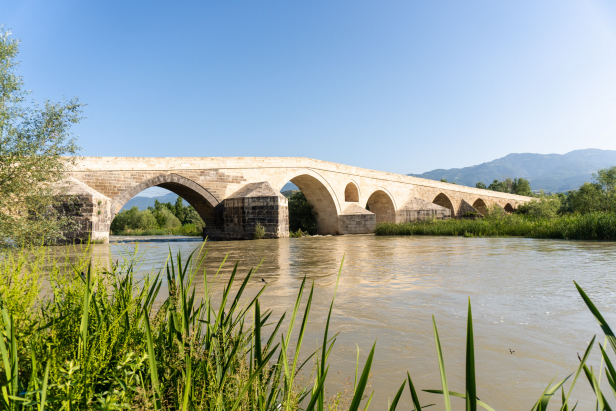The Historic Talazan Bridge
Tarihi Talazan Köprüsü
/ By Josh
Cost: Free
Great for: Danishmendid History, Seljuk History, Bridges
The north of Tokat province is dominated by a wide river valley through which the Kelkit flows westward to the Yeşilırmak, the Green River, and on to the sea. The Talazan Bridge was built some time in the medieval period while the region was under Turkic control, allowing the city of Niksar (ancient Neokaisareia) access to the surrounding lands south of the Kelkit River.
The original inscription stone is missing from Talazan Bridge and so exactly who built it and when is uncertain. Based on the construction methods and the area’s general history it is believed that the bridge was built sometime in the 13th century during the Seljuk period. Other sources suggest an earlier origin of the 11th century with the builders being the Danishmendids, a Turkic power who ruled from nearby Niksar. While the Seljuk origin is more commonly held it is difficult to prove beyond doubt.
Further muddying the origin of the bridge is the fact that it was damaged and repaired a number of times throughout its history. In more recent history the bridge was damaged in a series of earthquakes with a section of the bridge being damaged and eventually collapsing in 1942. The collapsed arches were replaced by a steel deck supported by trusses. In 2012 restoration work was completed and the bridge returned to a more historic form. Traffic to and from nearby villages still uses the historic bridge today.
The bridge is 161 meters long with a sloping bridge deck that rises up to meet the height of the highest arch. The peaked bridge deck is a common design for bridges built in this era; it allows a larger central arch to span the harshest of the rivers flow while lesser arches allow the rest of the waters flow to pass through while supporting the outward force of the larger arches and passing the weight to the ends of the bridge.
Subscribe to The Art of Wayfaring
Talazan Bridge is made up of eight arches (pictures from before the restoration show seven, though the gap in the middle may have been made by the collapse of two spans rather than one). The primary arch is not in the center, rather there are two arches to the south of the main arch and five to its north. The bridge piers are supported on the up-stream side by a set of heavy cutwaters, triangular masses of masonry that protect the bridge by cutting the waters flow.
How To Get There
General
Talazan Bridge is just under 2 kilometers from the main road (E80 highway or Amasya-Erzurum Road) which has decent bus traffic along it. It is possible to get out at the junction and walk to the bridge. As getting back on a bus may be somewhat complicated from here, we’d recommend visiting by car. The bridge can be found just north of the E80 highway with signs marked for “Talazan Köprüsü”.
For more about car rental and driving in Turkey make sure to read our drivers guide.
Where To Stay
The nearby town of Niksar (15 kms) is a fair-sized town with a couple of hotels to choose from. The city of Tokat (60 kms) is much larger with more options to choose from. Amasya (90 kms) is larger and more touristic yet with lots of hotel options ranging from run-of-the-mill, to riverside rooms in historic Ottoman mansions.
Other Tips
Planning on visiting the Historic Talazan Bridge? Make sure to check out what other sights are in nearby Çorum and Amasya or in the Central Turkey Region!
Subscribe to The Art of Wayfaring
Have any tips or info to add? Spot any mistakes? We’d love to hear about it.


